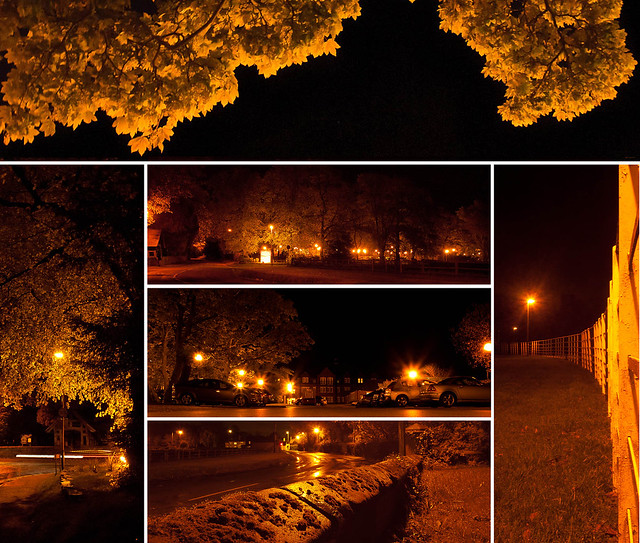A couple of people on Flickr have recently asked me where I’m going with my night time shots – both the black and whites and the sodium/tungsten lighting shots. In all honesty I’m not fully sure – there seems to be something there that’s a bit beyond my grasp at the moment. My response has been to keep taking the shots and as I said in response to one of the comments try to extract a thread.
I think the following quote in the Hockney book is one of those threads – it’s certainly worthy of some investigation and experiment:
“..a photograph sees it all at once, in one click of the lens from a single point of view, but we don’t. And it’s the fact that it takes us time to see it that makes the space.”
I take this to mean that our perception of space is related to our memory – we’re seeing lots of individual “shots” of the scene and our brain/memory is piecing them together to make a whole. It was this he was pursuing in his multi-point perspective ‘joiners’ when he was experimenting with photography.
To me there feels to be more to it than this. When I remember a place – or the sense of a place – I don’t remember it as a single image – even if it’s really remarkable. Of all the places I’ve visited Uluru is my favourite – but I don’t remember a single image of it – more a collection of images that build up to form my memory. So where does that take me? How do we use photography to create both a sense of space, and a permanent ‘memory’ (as opposed to image) of a place – in other words a genuine sense of space and place?
I’m a bit of a literal soul at times, so the place to start seems to be to replicate the building process I perceive in my memory – take several shots and view them together. The key point here is it is not about building a multi-shot panorama – it’s about combining images that not only serve to give you a sense of place, but that also work together to give a sense of space. The six shots I chose for this first attempt are in this set on Flickr together with a couple of others I rejected while working out the final result. They are not all taken from the same place – in fact they are not all visible at once from any location - but they are things that trigger memories for me, and they are all of Stretton – near Warrington. Combining them in a reasonably logical way – sky at the top, roadways at the bottom etc. - produces this final composite image:

For the record all the shots were taken at ISO1600 on an an E-P1 with a 17mm lens. Post processing was generally limited to the crop although in a couple I adjusted the contrast with curves in Lightroom to deepen the blacks, one (the car park) had a sight colour balance adjustment and a in a couple I brightened the red and orange channels a little to bring the colours back after the contrast adjustment.
As a first attempt this feels to work quite well – the lines leading into the picture combine with the ‘flatter’ images to to provide a sense of volume, and the pictures work reasonably well together to give an idea of what you might find there and the sense of otherworldly lighting from the multiple artificial light sources is conveyed fairly well. The absence of a shot across the bottom also seems to emphasise a sense of being ‘under the trees’.
This has me wondering if I shouldn’t investigate the images of Uluru in my computer memory to see if I can produce a similar image to match my real memory. I’d be interested to know what anyone else thinks.
1 comment:
Hi Nigel,
This is a very compelling series and the shots work well together here. An interesting response to Hockney's joiners and I think your analysis of photography and memory is extremely valid.
I don't know whether you have seen the documentary 'Hockney on Photography'? (I caught it a couple of months ago on Sky Arts) In it Hockney discusses at length the kind of ideas you express here and comments on his work and art. Well worth seeing if you can catch it.
Cheers, Michael.
Post a Comment